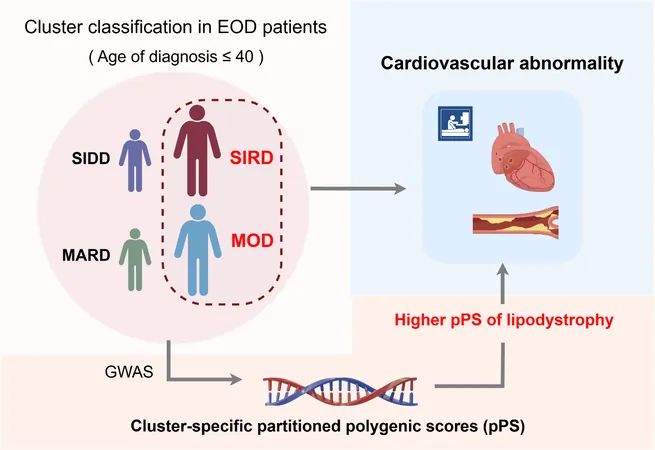
Alarming Cardiovascular Risks Uncovered in Young Adults with Early-Onset Type 2 Diabetes!
2025-03-26
Author: Siti
Research has unveiled shocking findings: cardiovascular abnormalities may already be present in individuals diagnosed with type 2 diabetes before the age of 40. Defined as early-onset type 2 diabetes, this form of diabetes is becoming a critical health epidemic of the 21st century, particularly affecting younger populations. A staggering 11.5% of all diabetes patients in China fall within the 18–40 age group, as indicated by recent studies on chronic diseases and risk factors.
Recent evidence underscores that early-onset type 2 diabetes manifests more aggressively than its later-onset counterpart. These patients face twice the risk of developing serious macrovascular complications, with studies reporting an alarming correlation between early onset and increased cardiovascular mortality rates. Alarmingly, a cross-sectional study indicated that those diagnosed early had a heightened risk of non-fatal cardiovascular Diseases as compared to their late-onset peers.
Two extensive cohort studies have shed light on the cardiovascular risks faced by young diabetes patients. The TODAY study revealed that serious heart issues—like deteriorating left ventricular diastolic function—emerged just 5-10 years post-diagnosis. Moreover, 15.8% of adolescents and young adults were found to have significant structural heart abnormalities. Meanwhile, the SEARCH study painted a similarly concerning picture, with over 25% of young diabetes patients exhibiting heart structure issues, including left ventricular hypertrophy.
Currently, there is a notable gap in our understanding regarding the presence of cardiovascular complications at the initial stages of early-onset diabetes. A nationwide registry suggests that diabetes patients experience double the cardiovascular event rate 30 years ahead of their diagnosis compared to healthy controls, yet targeted studies on early-onset patients remain scarce.
Diabetic cardiomyopathy (DCM)—characterized by significant structural, functional, and metabolic heart changes—grows more concerning in early-onset diabetes cases. Early indicators of DCM include left atrial enlargement and diastolic dysfunction, which can progress to heart failure symptoms. This deterioration stems from insulin resistance and associated metabolic disruptions, independent of other risk factors like hypertension.
To further comprehend this issue, the START cohort was established in 2021 at Peking University People’s Hospital to assess cardiovascular abnormalities in newly diagnosed early-onset diabetes patients. In total, 400 patients were recruited, revealing a staggering detection rate of 26.3% for carotid artery abnormalities and 20% for echocardiographic irregularities within three months of their diagnosis.
Among various patient subtypes assessed, the severe insulin-resistant diabetes (SIRD) group reported a notably higher abnormal detection rate of 40% for carotid artery issues, reinforcing the link between insulin resistance and cardiovascular risk. Patients with SIRD also demonstrated a significant correlation between higher fasting C-peptide levels—indicating insulin secretion—and an increased risk for these abnormalities.
Moreover, echocardiographic examinations showed that 20% of the study participants had left atrial enlargement (LAE) and abnormal left ventricular geometry, often tied to pressure overload from obesity and hypertension. Notably, the SIRD subtype exhibited the highest prevalence of both conditions.
These preliminary findings convey an urgent message: individuals diagnosed with early-onset type 2 diabetes face significant risks of cardiovascular issues potentially at the moment of diagnosis. Common pathological changes, such as carotid intima thickening and plaque formation—indicators of atherosclerosis—call for immediate attention to lifestyle interventions, medication management, and aggressive screening protocols to mitigate potential health crises.
The implications of these findings are profound. As young adults today grapple with increasing diabetes incidence, the need for tailored preventative measures—including strict blood sugar management, weight control, and the use of heart-protective medications—is paramount.
Given the complexity of early-onset diabetes and its varied presentations, individualized treatment plans based on ongoing research will be essential for effectively addressing this growing public health challenge. The time to act for these younger populations is now—before cardiovascular diseases become their inevitable fate!





 Brasil (PT)
Brasil (PT)
 Canada (EN)
Canada (EN)
 Chile (ES)
Chile (ES)
 Česko (CS)
Česko (CS)
 대한민국 (KO)
대한민국 (KO)
 España (ES)
España (ES)
 France (FR)
France (FR)
 Hong Kong (EN)
Hong Kong (EN)
 Italia (IT)
Italia (IT)
 日本 (JA)
日本 (JA)
 Magyarország (HU)
Magyarország (HU)
 Norge (NO)
Norge (NO)
 Polska (PL)
Polska (PL)
 Schweiz (DE)
Schweiz (DE)
 Singapore (EN)
Singapore (EN)
 Sverige (SV)
Sverige (SV)
 Suomi (FI)
Suomi (FI)
 Türkiye (TR)
Türkiye (TR)
 الإمارات العربية المتحدة (AR)
الإمارات العربية المتحدة (AR)